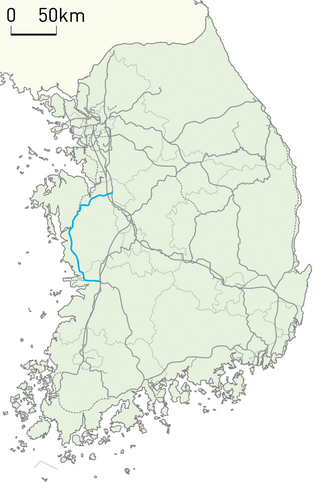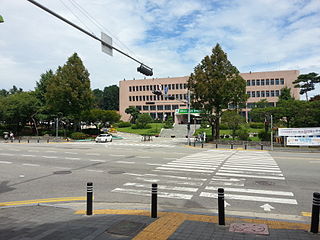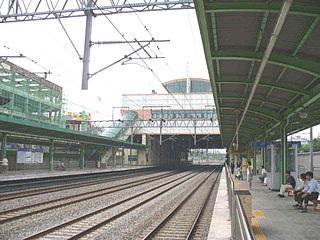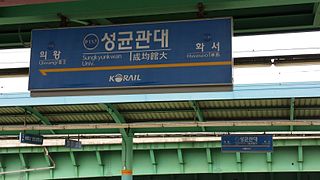
The Gyeongbu line (Gyeongbuseon) is a railway line in South Korea and is considered to be the most important and one of the oldest in the country. It was constructed in 1905, connecting Seoul with Busan via Suwon, Daejeon, and Daegu. It is by far the most heavily travelled rail line in South Korea.

The Janghang Line is a railway line serving South Chungcheong Province in South Korea. The line connects Cheonan to the railway junction city of Iksan. The Janghang Line is served by frequent Saemaeul-ho and Mugunghwa-ho passenger train services between Seoul and Iksan. There is also a link from Asan station to the KTX network at Cheonan-Asan station.

Cheonan is the largest and most densely populated city of Chungcheongnam-do, South Korea, and the third largest city in the Hoseo region after Daejeon and Cheongju. Cheonan borders Gyeonggi-do in the north, Chungcheongbuk-do to the east and southeast, Sejong City to the south and Asan-si and Gongju-si to the west and southwest.

Seoul Subway Line 1 of the Seoul Metropolitan Subway is a rapid transit and commuter rail line which links central Seoul, South Korea to Yeoncheon in the northeast, Incheon in the southwest, and Sinchang via Suwon and Cheonan in the south. The central underground portion of Line 1, running underneath Sejongno, Jongno, and Wangsan-ro avenues along Seoul's traditional downtown area, is the oldest subway-operated section in the Seoul Metropolitan Subway system. Its branches and services cover a large part of the Seoul Capital Area; totaling 200.60 km (124.65 mi) in route length.

Songtan is an area in the northern end of Pyeongtaek, Gyeonggido, South Korea. Songtan achieved city status in its own right in 1981, five years earlier than Pyeongtaek, but merged, along with Pyeongtaek County, into Pyeongtaek City in May 1995.

The Mugunghwa-ho (Korean: 무궁화호) is a class of train operated by Korail, main railway operator of South Korea. Mugunghwa trains are Korail's slowest tier of trains stopping at a number of towns and villages, and operating over a number of lines that are not served by other trains. Journey times are generally twice that of KTX trains and 25% longer than ITX express trains.

The Commuter Train were a class of short-run commuter trains operated by Korail, the national railroad of South Korea. They operated once or twice daily in each direction, along a few tens of kilometers of track. They provided an important function for many smaller rural communities, which often lack good transit connections. Commuter Train operations on the Gyeongwon line was temporarily suspended its operation on April 1, 2019, due to the construction and partial electrification of the line for the Soyosan-Yeoncheon extension of Seoul Subway Line 1. They were permanently suspended on December 16, 2023, after the opening of the extension, and due to the old age of CDC trains. Commuter trains last operated on the Gwangju Line in Gwangju between GwangjuSongjeong and Gwangju station, from January 1, 2020, until December 17, 2023, permanently being phased out due to the old age of CDC trains.

Songtan Station is a ground level metro station in Songtan, a district of Pyeongtaek in Gyeonggi Province, South Korea. The station is on Line 1 of the Seoul Metropolitan Subway, which runs from Soyosan in Dongducheon to Cheonan in Chungcheongnam-do. The line also serves Osan, Suwon, and Seoul.

Suwon Station is a railway station in the city of Suwon, South Korea. The station was completely redeveloped in 2002 and 2003, and is now integrated with the Aekyung Shopping Mall. This station serves Inter-city railway Gyeongbu Line KTX, ITX-Saemaeul and Mugunghwa will stop. Also Line 1, Suin–Bundang Line of the Seoul subway will stop. And this station is an important hub in southern Gyeonggi Province.

Geumjeong Station is a ground-level metro station on lines 1 and 4 of the Seoul Subway network in South Korea. The station is in Gunpo, a city approximately 15 km (9.3 mi) south of Seoul in Gyeonggi Province, between the cities of Anyang and Suwon. The name means that the land is covered with waves everywhere and that the water wets women's clothes.

Yeongdeungpo station is a ground-level railway station in Seoul, South Korea. The station is located in Yeongdeungpo Dong, Yeongdeungpo-gu, and is a stop on the Gyeongbu Line, Honam Line and Seoul Subway Line 1. The station is integrated into the Yeongdeungpo Lotte Department Store. Located in the station are Lotteria, Dunkin' Donuts, Krispy Kreme, and KFC.

Guro Station (Korean: 구로역) is a subway station in Guro District in Seoul, South Korea. It serves Seoul Subway Line 1.

Sungkyunkwan University Station is a ground-level metro station on line 1 of the Seoul Subway in Yuljeon Dong, Jangan Gu, Suwon, South Korea. The station is nearby Sungkyunkwan University and Dongnam Health College. Travel time from Sungkyunkwan University Station to Seoul Station on Line 1 is 54 minutes, and travelling to Sungkyunkwan University's other campus, by Hyehwa Station in Seoul, takes 67 minutes, transferring to Line 4 at Geumjeong. The original station building was demolished, and a new, larger building incorporating shops, clinics, and a car park, was built, opening in late 2016.

Cheonan–Asan station is a ground-level train station located mostly in Asan, Chungcheongnam-do, although part of it lies in the neighboring city of Cheonan. This station serves high-speed KTX trains that run from Seoul to either Busan or Mokpo. It is connected to Asan station, a railway station on the Janghang Line which is also served by Line 1 of the Seoul Subway.

Pyeongtaek Station is the main train station serving the city of Pyeongtaek, South Korea. It is on the Gyeongbu Line and is also served by Seoul Subway Line 1. It is not a KTX station, but the KTX stops here and there is a ticket counter. There are a number of large department stores, restaurants, and a movie theater located in the subway station. The cinema is located on the 8th floor and is a CJ CGV multi-screen facility with a 3-D screen. On the 3rd floor there are Baskin Robbins, Starbucks, and a large food court featuring a Lotteria fast food restaurant. The station is also located in the middle of the city of Pyeongtaek and many stores and restaurants are outside the station.

Geumcheon-gu Office Station, formerly known as Siheung Station, is a station on the Line 1 of the Seoul Subway, as well as the Gyeongbu Line. Commuter rail trains on Line 1 travel southwards from here to Anyang, Suwon, Pyeongtaek and Cheonan Stations via the Gyeongbu Line.

Asan Station is a railway station on the Janghang Line which is also served by Line 1 of the Seoul Subway. Its located in Baebang-eup, Asan-si, Chungcheongnam-do, South Korea. Meanwhile, is served by all Saemaeul-ho and Mugunghwa-ho services on the Janghang Line.

Pyeongtaek–Paju Expressway is an expressway in South Korea. It connects Pyeongtaek to Paju in Gyeonggi Province. The expressway's route number is 17, which it shares with the Iksan–Pyeongtaek Expressway. This expressway overlaps with the Capital Region Second Ring Expressway at Hwaseong.

The Intercity Train eXpress-Saemaeul abbreviated as ITX-Saemaeul (Korean: ITX-새마을) is a class of train operated by Korail, the national railroad of South Korea, it was introduced on May 12, 2014, to replace the Saemaeul-ho. The new ITX-Saemaeul trains have a faster average speed of 150 kilometers per hour. The name was taken from the Saemaul Undong after a public competition to determine the new train's name.

Nuriro (Korean: 누리로) is a class of train operated by Korail, the national railroad of South Korea, it was introduced on June 1, 2009, to replace the short-range Mugunghwa-ho. The train was introduced as a replacement for the Bidulgi-ho/Tongil-ho/Mugunghwa-ho operating system between Seoul and Onyangoncheon, and will replace the short-range Mugunghwa-ho when a new train comes in. However, due to various problems, it is currently operating in Yeongdong Line and Jungang Line as a replacement for Mugunghwa-ho.




















